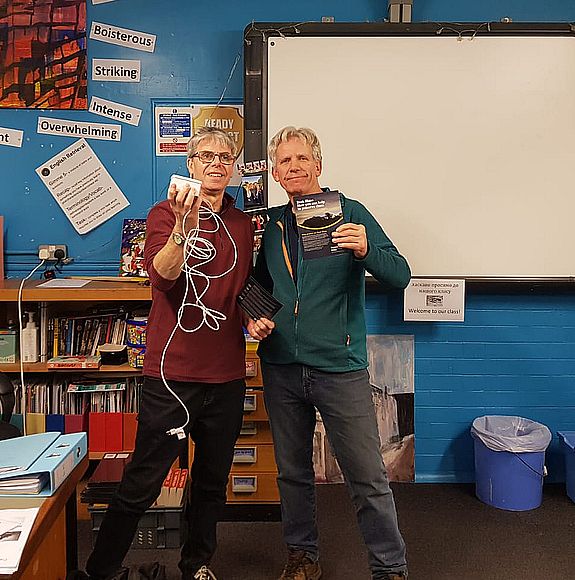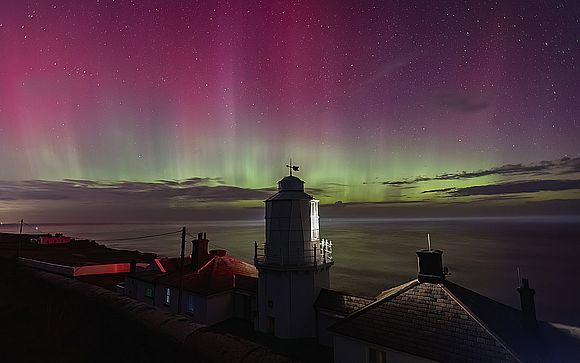Society meetings in 2024 kicked off in fine style with our guest speaker Richard Darn travelling across to Whitby to give a talk on the ‘North York Moors Dark Night Survey’. The evening started in hectic fashion, having previously emailed Richard the Caedmon College postcode, Mark received a call off him less than half an hour before the meet start enquiring whether he was at the right college. It became apparent from Richard's description of his surroundings, he wasn't. For some reason the postcode given had sent him to the wrong college - the Sixth Form College - formally Caedmon School. Mark soon located Richard, escorting him back to the correct College - namely Caedmon College.... yes, it is very confusing!
There is also a tale of WDAS members having to loiter outside the public toilets in Aisalby, waiting to pick up a stranded member, (thanks Barbara and Mark - Richard was very grateful). Eventually, everyone intending on coming along made it safely to the college, where Richard was given a warm introduction.
 Richard (green top) with Mark, holding up a new automated light meter now being deployed. Image - Mark Gratton. (Click to enlarge)
Richard (green top) with Mark, holding up a new automated light meter now being deployed. Image - Mark Gratton. (Click to enlarge)
Following some background information on himself, Richard told tales of adventures he'd had visiting dark sky locations over many years, including several wonderful looking sites in America. Having assisted in Northumberland - particularly the Kielder Forest area, where he helped set up the observatory and co-founded the Kielder Forest star camp event, Richard revealed how sky data is crucial to any organisation seeking dark sky status, and why certain criteria are required to be met for the IDA (International Dark Sky Association) before granting this.
In respect of the NYMNP (North York Moors National Parks) bid, much of the early groundwork was undertaken during the Covid pandemic. Light meter readings of the night sky were taken using manual light meters by Richard and others to ascertain whether skies were dark enough to qualify. Richard proved they were, being incorporated within the bidding assessment document sent by NYMNP, which included details of benefits, impacts, required and necessary changes to achieve, and maintain DSRS (dark sky reserve status). As we know the bid was ultimately successful.
Richard showed some fantastic images, showcasing the beauty of the night sky from our area. One caught our attention, an aurora over the North Sea, with image credited to Richard Randle. Unbeknown to Richard Darn, Richard R was sat just a few meters away, much to the mirth of everyone present. One matter all agreed upon, which was backed up by current data, was just how rubbish the weather has been lately. Richard giving a 'clear night' percentage figure from October of less than 20%, and don't we know it!
As Richard stated, meter readings are pivotal, (if your sky just isn’t dark enough, any bid is not going to fly from the get-go). Richard gave insight into the reading levels themselves, how, where, and when they are taken - often in the early hours of the morning. He showed us an example of a manual light meter – which can be purchased from as little as £120. Simple to use, all that is required are clear skies, some travelling and zombie hour timings!
The collective data from these meters was then mapped out to create a dark sky picture. Richard pointed out that darkness levels in the UK vary markedly. Areas of Scotland, Wales, and parts of Northumberland as good as it gets in the UK, with levels comparable to locations much more exotic. The Yorkshire Dales are slighter darker than the NYM, nevertheless 'good, dark skies' can be found on our doorstep. The IDA adopted new Dark Sky Park designation requirements in June 2018 that not only specified a new minimum Sky Quality Meter (SQM) reading at the zenith of 21.2 magnitudes per square arcsecond or better, but additionally required any artificial light domes on the horizon to be “dim, restricted in extent, and close to the horizon.”
Meter readings taken by Richard and others showed SQM values of 21.3 and above in various locations around the NYM district. Following DSRS being granted to the NYM and Dales NP in 2020, additional light meter data from many more locations within NYMNP has Richard more confident that the darkest areas are larger than originally submitted. The darkest sky levels recorded were north of Pickering, with coastal areas around RHB and Ravenscar not far behind.
Richard highlighted some of the problem areas achieving and maintaining DSRS with regard to new LED lighting, chiefly colour rendering. Although most authorities now employ LED fixture streetlighting of full cut-off design, ie pointing downwards. The issue with LED lighting is temperature rating, with ‘cool white’ light often used. Light spill off streetlamps is being reduced, however it is within the private and domestic sector problems are arising, with many inappropriate lighting fixtures being installed, often at the wrong angle and not using warm white (2000-3500 degrees) rendering. This causes unwanted 'sky glow', and 'light domes' over towns and cities.
Take Teesside as an example. From data collected from light meter instruments, effects from the light dome over Teesside can be detrimental up to 35km away. Night skies from locations sheltered by terrain within that range may still be dark, but not as dark as they could be. Thankfully all is not lost, with lighting manufacturers increasingly making use of CCT switchable technology, allowing light temperature to be altered by the flick of a switch. With a little education on correct usage of lighting at night coupled with greater numbers of people experiencing for themselves the majesty of truly dark night skies, the better the chances future night skies will be darker for all to enjoy.
Increasingly new automated light meters are being deployed within the NYMP area, which give better in-depth and continual evaluation of the night sky at their sited location. The only downside being power and internet requirements. These typically cost several hundred pounds. The data collated from these can be accessed on the TESS Dashboard site based in Spain. (Andi will appreciate this). The web addresses for the 3 automated sensors are as follows. .
https://tess.dashboards.stars4all.eu/d/datasheet_stars807/stars807?orgId=1
https://tess.dashboards.stars4all.eu/d/datasheet_stars1054/stars1054?orgId=1
https://tess.dashboards.stars4all.eu/d/datasheet_stars999/stars999?orgId=1
It was a very thought provoking and inspiring talk, greatly enjoyed by all present. So much so the clock read 9:40pm when we vacated the classroom! It reveals just what can be achieved, with modest equipment and a willingness to make a difference. Something we can all strive to achieve. We look forward to Richard returning next year - perhaps with a larger audience, the subject matter deserves it!
For further reading on this subject visit:
https://gostargazing.co.uk/dark-sky-sites-across-uk/
https://www.cpre.org.uk/what-we-care-about/nature-and-landscapes/dark-sk...
- Log in to post comments

